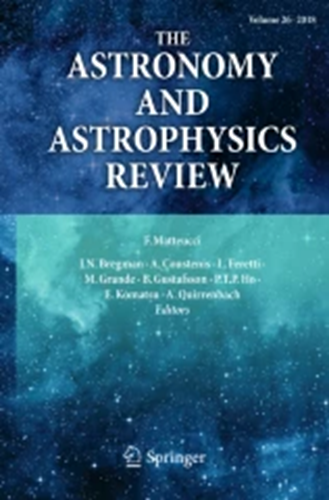From electrons to Janskys: Full stokes polarized radiative transfer in 3D relativistic particle-in-cell jet simulations
IF 26.5
1区 物理与天体物理
Q1 ASTRONOMY & ASTROPHYSICS
引用次数: 1
Abstract
The underlying plasma composition of relativistic extragalactic jets remains largely unknown. Relativistic magnetohydrodynamic (RMHD) models are able to reproduce many of the observed macroscopic features of these outflows. The nonthermal synchrotron emission detected by very long baseline interferometric (VLBI) arrays, however, is a by-product of the kinetic-scale physics occurring within the jet, physics that is not modeled directly in most RMHD codes. This paper attempts to discern the radiative differences between distinct plasma compositions within relativistic jets using small-scale 3D relativistic particle-in-cell (PIC) simulations. We generate full Stokes imaging of two PIC jet simulations, one in which the jet is composed of an electron-proton ($e^{-}$-$p^{+}$) plasma (i.e., a normal plasma jet), and the other in which the jet is composed of an electron-positron ($e^{-}$-$e^{+}$) plasma (i.e., a pair plasma jet). We examined the differences in the morphology and intensity of the linear polarization (LP) and circular polarization (CP) emanating from these two jet simulations. We find that the fractional level of CP emanating from the $e^{-}$-$p^{+}$ plasma jet is orders of magnitude larger than the level emanating from an $e^{-}$-$e^{+}$ plasma jet of a similar speed and magnetic field strength. In addition, we find that the morphology of both the linearly and circularly polarized synchrotron emission is distinct between the two jet compositions. We also demonstrate the importance of slow-light interpolation and we highlight the effect that a finite light-crossing time has on the resultant polarization when ray-tracing through relativistic plasma.从电子到扬斯基:三维相对论粒子胞内射流模拟中的全斯托克斯极化辐射传输
相对论性河外喷流的潜在等离子体组成在很大程度上仍然未知。相对论磁流体力学(RMHD)模型能够重现许多观测到的这些外流的宏观特征。然而,超长基线干涉(VLBI)阵列检测到的非热同步辐射是射流中发生的动力学尺度物理的副产品,大多数RMHD代码中没有直接模拟物理。本文试图利用小规模三维相对论粒子池(PIC)模拟来辨别相对论射流中不同等离子体组成之间的辐射差异。我们生成了两个PIC射流模拟的全Stokes成像,其中一个射流由电子-质子($e^{-}$-$p^{+}$)等离子体组成(即正常等离子体射流),另一个射流由电子-正电子($e^{-}$-$e^{+}$)等离子体组成(即一对等离子体射流)。我们研究了这两种射流模拟产生的线偏振(LP)和圆偏振(CP)的形态和强度的差异。我们发现,从$e^{-}$-$p^{+}$等离子体射流中发出的CP的分数阶比从相同速度和磁场强度的$e^{-}$-$e^{+}$等离子体射流中发出的CP的分数阶要大几个数量级。此外,我们发现在两种射流组成中,线偏振和圆偏振同步辐射的形态是不同的。我们还证明了慢光插值的重要性,并强调了当射线追踪通过相对论等离子体时,有限的光穿越时间对合成偏振的影响。
本文章由计算机程序翻译,如有差异,请以英文原文为准。
求助全文
约1分钟内获得全文
求助全文
来源期刊

The Astronomy and Astrophysics Review
地学天文-天文与天体物理
CiteScore
45.00
自引率
0.80%
发文量
7
期刊介绍:
The Astronomy and Astrophysics Review is a journal that covers all areas of astronomy and astrophysics. It includes subjects related to other fields such as laboratory or particle physics, cosmic ray physics, studies in the solar system, astrobiology, instrumentation, and computational and statistical methods with specific astronomical applications. The frequency of review articles depends on the level of activity in different areas. The journal focuses on publishing review articles that are scientifically rigorous and easily comprehensible. These articles serve as a valuable resource for scientists, students, researchers, and lecturers who want to explore new or unfamiliar fields. The journal is abstracted and indexed in various databases including the Astrophysics Data System (ADS), BFI List, CNKI, CNPIEC, Current Contents/Physical, Chemical and Earth Sciences, Dimensions, EBSCO Academic Search, EI Compendex, Japanese Science and Technology, and more.
 求助内容:
求助内容: 应助结果提醒方式:
应助结果提醒方式:


